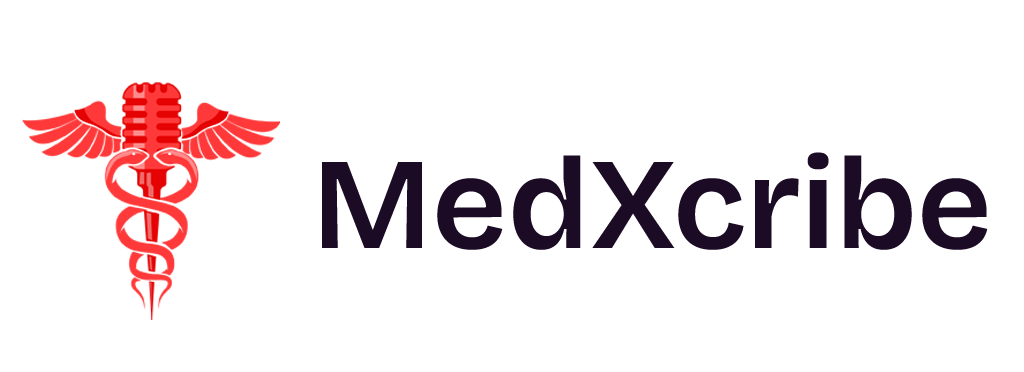The Importance of Summaries in Medical Transcripts

Medical transcripts are an important part of healthcare, capturing detailed records of patient visits, diagnoses, and treatments. Among these records, summaries play a key role in making medical information easier to access, understand, and use. MedXcribe is a powerful transcription tool that takes this process further by providing fast, accurate, and secure summaries. Designed for healthcare professionals, MedXcribe simplifies workflows, reduces repetitive work, and ensures essential patient information is always easy to find. Here’s why MedXcribe’s summaries are so valuable in modern healthcare. https://www.youtube.com/watch?v=drWCZnEgQwc Helping Doctors Make Faster Decisions In fast-paced medical environments, doctors need immediate access to critical patient information. Summaries provide a clear and concise overview of a patient’s condition, medical history, and treatment plans, enabling faster and more informed decisions. MedXcribe simplifies this process by automatically creating summaries from voice-to-text transcripts, emphasizing key details such as symptoms, diagnoses, and treatment plans. This enables doctors to focus on patient care instead of wasting time on lengthy documentation. Saving Time for Healthcare Professionals Healthcare professionals manage numerous tasks daily, making it challenging to review lengthy transcripts. Summaries distill essential details, such as prescribed medications and follow-up actions, saving valuable time and effort. With its offline transcription capabilities, MedXcribe converts voice inputs into precise summaries instantly. This ensures healthcare professionals like Priya have the information they need, exactly when they need it, making their work more efficient and less stressful. Simplifying Patient Communication Patients often struggle to understand complex medical records, which can make it difficult for them to stay informed and engaged in their care. Summaries simplify these records, providing clear explanations that help patients better understand their health. MedXcribe ensures that important details are communicated clearly and in a patient-friendly manner. This not only improves understanding but also builds trust and engagement between patients and their healthcare providers. Supporting Legal and Compliance Requirements Medical transcripts are often essential for legal purposes and audits. Summaries help streamline the process by highlighting critical details, ensuring compliance with healthcare regulations, and reducing the risk of errors. MedXcribe ensures healthcare providers meet regulatory requirements by delivering accurate and well-organized documentation. This reduces compliance risks and provides peace of mind during audits or legal reviews. Streamlining Follow-Up Care Follow-up appointments are vital for ensuring positive health outcomes. Healthcare providers need a quick and accurate overview of a patient’s history and prior treatments to deliver focused and effective care. Summaries play a key role in making these consultations efficient and productive. MedXcribe delivers clear and concise summaries that make follow-up visits smoother and more productive. This continuity of care not only enhances efficiency but also ensures better outcomes for patients. Enhancing Team Collaboration Healthcare teams—comprising doctors, nurses, and specialists—depend on clear and effective communication to deliver comprehensive patient care. Summaries provide a unified view of a patient’s status, making collaboration seamless and ensuring every team member is aligned. MedXcribe facilitates interdisciplinary collaboration by providing accurate and consolidated summaries. This ensures healthcare teams can work together seamlessly, delivering the best possible outcomes for patients. Empowering Research and Analysis Medical records are invaluable for research, quality improvement, and identifying healthcare trends. Summaries play a crucial role by making data more accessible and easier to analyze, leading to meaningful insights and advancements. By providing structured and summarized data, MedXcribe streamlines the research process and supports healthcare advancements, enabling professionals like Dr. Kavya to focus on generating insights that drive better patient outcomes. Enhancing Continuity of Care Continuity of care is essential for achieving positive health outcomes, especially for patients with chronic conditions or complex medical histories. It relies on accurate and comprehensive documentation that enables healthcare providers to deliver consistent and informed care over time. MedXcribe enhances continuity of care by providing healthcare providers with accurate, organized, and readily available patient information. It empowers professionals like Dr. Suresh to make informed decisions, reduce errors, and improve patient outcomes. For managing complex cases, MedXcribe is more than a transcription tool—it’s a trusted partner in delivering consistent, high-quality care. In today’s fast-moving healthcare environment, accuracy and efficiency are critical. MedXcribe makes medical documentation easier and more reliable with its advanced transcription and summary features. It helps healthcare professionals save time, reduce mistakes, and make better decisions. Whether it’s helping doctors quickly diagnose patients, simplifying follow-up care, or meeting compliance requirements, MedXcribe changes how medical records are managed. More than a transcription tool, MedXcribe is a trusted partner in providing excellent care, improving patient outcomes, and shaping the future of healthcare.
How to Transcribe Medical Podcasts with MedXcribe
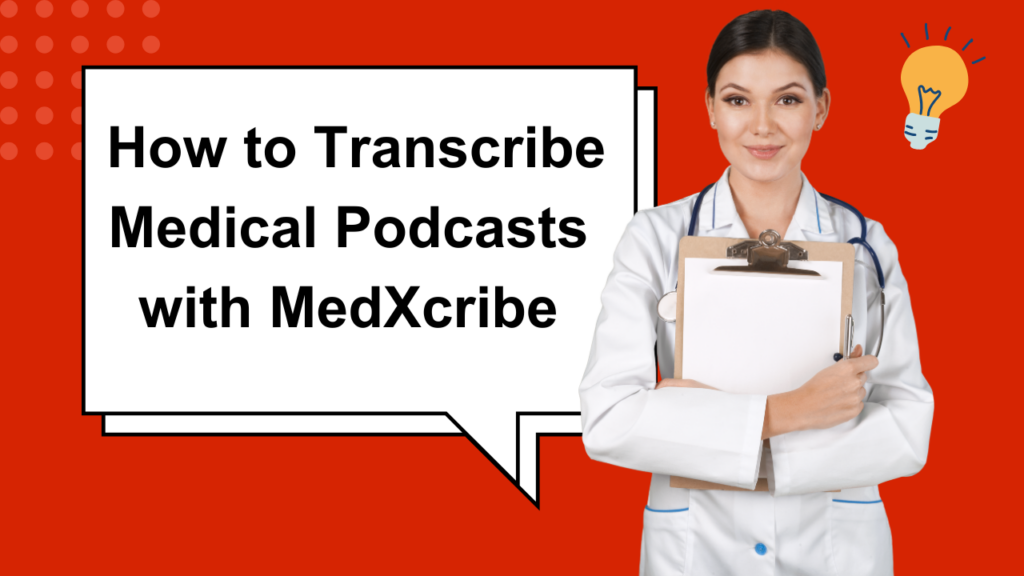
Transcribing medical podcasts is now simpler than ever, thanks to the efficient and user-friendly tool, MedXcribe. Whether you’re a transcriptionist, medical professional, or student, this tool streamlines the process and provides accurate results in just minutes. In this blog, we’ll walk you through the step-by-step process of transcribing a podcast using MedXcribe, featuring a podcast on heart transplantation as an example. For a detailed walkthrough, check out our video on how to transcribe medical podcasts using MedXcribe. https://youtu.be/l8u6dUSKVzQ Step 1: Visit the Website Start by visiting the MedXcribe website. You’ll have the option to choose between the web app or the iOS app, depending on your preference. Select the one that works best for you to begin the transcription process. Step 2: Upload Your Audio Once you’ve selected the app, it’s time to upload your audio file. MedXcribe makes this simple: Paste the URL of the audio file, or Select the file directly from your device. This flexibility ensures you can quickly get started, regardless of where your audio file is stored. Step 3: Click the Transcribe Button After uploading your audio file, click the Transcribe button. MedXcribe will begin processing the audio and generating a transcription. The tool’s advanced algorithms ensure accuracy, even for longer audio files. Step 4: Review the Transcription Once the transcription is ready, take a moment to review it. This step is essential to ensure the content meets your expectations and is free of errors. MedXcribe’s intuitive interface makes it easy to make edits if needed. Step 5: Save or Download the Transcription When you’re satisfied with the transcription, save or download it in your preferred format. MedXcribe supports multiple formats, making it convenient for various uses. Demo Check out a demo of generating Medical Transcripts for the Hodgkin’s Lymphoma Explained (With Classification) podcast. Why MedXcribe? MedXcribe stands out for its speed and accuracy. As demonstrated in the video, it can transcribe even long audio files in just a minute. This feature saves valuable time for transcriptionists, making it an indispensable tool for professionals and students alike. And that’s it! Transcribing medical podcasts with MedXcribe is quick, easy, and efficient. Whether you’re working on a podcast, lecture, or any other medical audio content, MedXcribe delivers high-quality transcriptions in no time. Give it a try and see the difference for yourself. We’d love to hear your feedback, so don’t forget to share your experience with MedXcribe! Happy transcribing! Step 5: Save or Download the Transcription
Quiz: Put Your Proofreading to the Test

How a Medical Transcriptionist Saved 70% of Time with MedXcribe
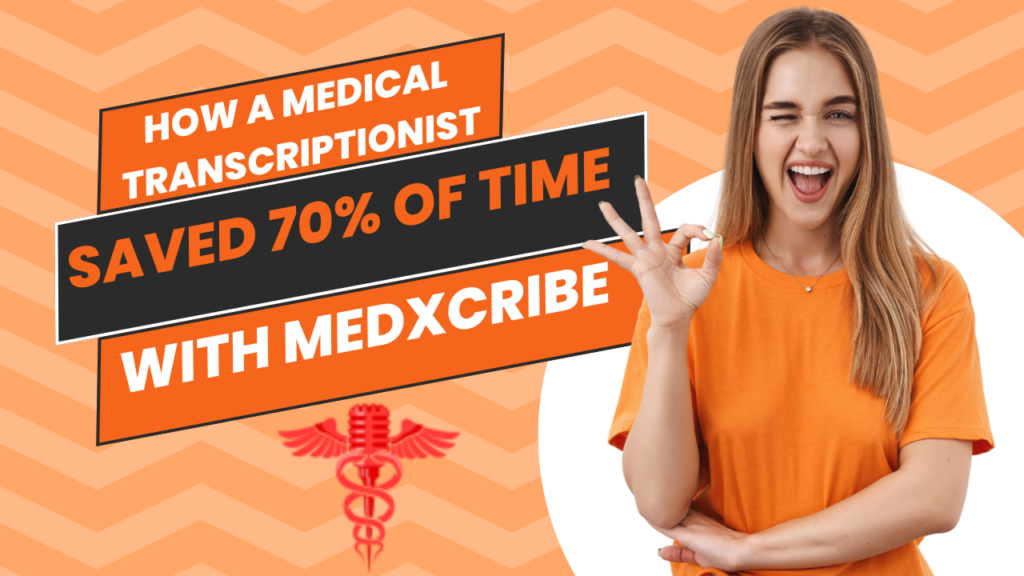
Transcriptionists like Kushi are tasked with converting doctors’ audio recordings into accurate medical records, often facing challenges such as unclear audio, complex medical terminology, and tight deadlines. For years, Kushi navigated these challenges with diligence, but the inefficiencies in her workflow led to unnecessary stress and long hours. Everything changed when she discovered MedXcribe—an offline iOS medical transcription app designed for exceptional accuracy. MedXcribe transformed Kushi’s workflow, saving her 70% of her time by addressing the key challenges of transcription. With its advanced features, Kushi no longer struggles with unclear audio or time-consuming manual edits. Instead, she can focus on producing high-quality transcriptions efficiently and without stress. MedXcribe is not just an app. It’s a transformative solution for transcriptionists seeking to enhance productivity and reduce the pressures of their demanding work. Accuracy That Eliminates Repetition Accurate transcription processes eliminate the need for repetitive corrections, saving time, enhancing efficiency, and ensuring high-quality outcomes. For Kushi, editing transcriptions was the most dreaded part of her job. Her previous tools frequently misinterpreted medical terminology, resulting in hours of tedious proofreading. A term as straightforward as “myocardial infarction” might be misrepresented, forcing her to spend valuable time fixing errors instead of progressing with her work. When Kushi switched to MedXcribe, the difference was immediately clear. The app effortlessly handled even the most complex medical jargon and abbreviations with impeccable accuracy. For the first time, she felt confident trusting the initial output. With the need for repetitive proofreading drastically reduced, Kushi’s editing time decreased by an impressive 60%. This newfound efficiency allowed her to focus on transcribing more files, significantly boosting her productivity and reducing stress. MedXcribe truly redefined her workflow. Seamless Offline Transcriptions MedXcribe’s offline functionality ensures uninterrupted work, even without an internet connection, boosting productivity and eliminating reliance on external factors. One rainy evening, a storm disrupted the internet in Kushi’s area, leaving her in a panic with an urgent deadline looming. Unlike her previous tools, which required a constant internet connection, MedXcribe’s offline capabilities came to the rescue. She quickly loaded the audio files onto her iPhone and completed the transcription directly on her device. By the time the internet was restored, Kushi had already finished and submitted her work, meeting her deadline effortlessly. With MedXcribe, Kushi no longer worries about internet disruptions. This reliable offline functionality has saved her from missed deadlines and unnecessary stress, while significantly improving her workflow. Kushi reported a 30% boost in overall productivity, driven by uninterrupted work and reduced dependency on connectivity. Streamlined Formatting MedXcribe’s automated formatting feature revolutionizes document creation by applying consistent styles effortlessly. This not only saves time but also ensures a professional, error-free presentation. For Kushi, formatting was one of the most tedious and time-consuming aspects of her work. Each hospital or clinic required specific layouts for their reports, forcing her to spend hours manually aligning headers, footers, and other elements. When she started using MedXcribe, this process was transformed. One day, while transcribing a batch of discharge summaries, Kushi noticed that the app automatically applied the correct formatting based on the requirements. What used to take hours was now completed in seconds. This innovation allowed Kushi to save significant time by eliminating manual formatting entirely. She reported a 40% increase in efficiency as a direct result of this feature. MedXcribe not only improved the accuracy of her transcriptions but also ensured every document adhered to professional standards, enhancing client satisfaction and streamlining her workflow. Effortless Audio Processing MedXcribe’s advanced audio processing transforms transcription by enhancing clarity through noise reduction and effective handling of accents. This innovation simplifies the process, drastically reducing the need for repeated playback, even in the most challenging audio conditions. Kushi often struggled with audio files recorded in noisy environments or from doctors speaking quickly with heavy accents. At times, the audio quality was so poor, with excessive background noise, that she would need to replay the files multiple times to catch every detail, consuming valuable time and effort. With MedXcribe, those challenges became a thing of the past. Even in cases where the audio was very poor, recorded in noisy environments or with difficult-to-understand accents, MedXcribe’s noise reduction and accent recognition features handled the transcription with remarkable accuracy and clarity. One particularly difficult file, recorded at a bustling cardiology clinic, was transcribed with exceptional precision, without the need for Kushi to replay the audio. The time spent dealing with poor-quality audio was reduced by 50%, enabling Kushi to process significantly more files each day. This breakthrough not only improved her efficiency but also made transcription less stressful and more productive, even when working with challenging audio conditions. Privacy-Compliant Efficiency MedXcribe ensures data security with privacy-compliant tools that streamline workflows, eliminating redundant steps for compliance while saving time and building trust. When Kushi’s hospital introduced stricter HIPAA compliance policies, her old workflow became increasingly cumbersome. She had to take extra steps to ensure data encryption and secure transfers, adding unnecessary complexity and delays to her transcription process. MedXcribe’s offline processing capabilities resolved these challenges effortlessly. By handling all transcriptions securely on her device, the app ensured complete compliance with data privacy regulations. During an internal audit, Kushi’s supervisor commended her workflow, impressed by how seamlessly MedXcribe integrated privacy compliance into her process. Kushi reported a 20% reduction in time spent on data security-related tasks, allowing her to focus on transcription without compromising compliance. MedXcribe not only simplified her workflow but also provided her with peace of mind, knowing her work met the highest standards of privacy and security. MedXcribe vs. Traditional Tools: A Time-Saving Comparison The table below highlights how MedXcribe revolutionizes medical transcription by addressing key inefficiencies in traditional tools, enabling a streamlined workflow and significant time savings. Feature Traditional Tools MedXcribe Time Saved Audio Processing Requires multiple playbacks to understand noisy or accented audio. Advanced audio processing with noise reduction and accent handling for clarity. 50% Formatting Manual alignment of headers, footers, and styles for each client. Automated formatting with customizable templates. 40% Offline Functionality
Common Challenges in Medical Transcription
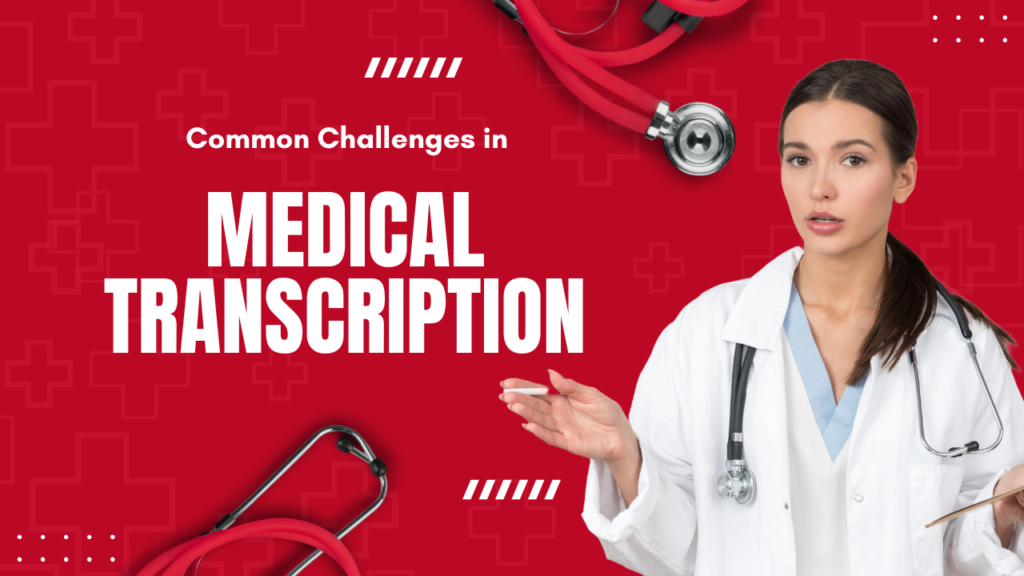
Medical transcriptionists play a critical role in healthcare by converting spoken medical reports into written documents. However, their work comes with a variety of challenges that can affect accuracy, efficiency, and well-being. Let’s explore some common hurdles and their impact, along with how innovative solutions like MedXcribe can address these issues. Challenges with Poor Audio Quality in Medical Transcription Poor-quality audio recordings in busy healthcare environments pose significant challenges for transcriptionists, impacting their efficiency and well-being. Meena, a transcriptionist at a radiology clinic, faced a particularly difficult task when she received an urgent audio file from Dr. Patel. The doctor had dictated an MRI report while walking through a noisy hospital hallway. The recording was filled with overlapping conversations and background noise, making it nearly impossible to understand key details about the patient’s condition. Determined to complete the task, Meena replayed the audio repeatedly, straining to catch every word. The process left her mentally exhausted and physically drained, with a pounding headache by the end of her shift. Despite her best efforts, the unclear audio delayed the final report, causing frustration for both Meena and the medical team. Key Thought: Poor audio quality delays workflows and disrupts documentation. It causes fatigue and strain from repeated playback. It leads to frustration and stress for transcriptionists. It increases the risk of errors in patient documentation, affecting care. Clear recordings and advanced tools ensure accurate, timely transcription. Challenges with Accents and Pronunciation in Medical Transcription Understanding diverse accents and speech patterns is a significant challenge for transcriptionists, often resulting in critical errors that affect workflows and patient care. Carlos, a transcriptionist in a busy cardiology department, frequently worked with audio files from an international team of doctors. One day, he received a recording from Dr. Chen, a cardiologist with a strong regional accent, dictating a coronary angiogram report. Struggling to interpret some of the terms, Carlos misheard “left anterior descending artery” as “left inferior descending artery.” The error slipped into the final report, causing confusion during a surgical team discussion and delaying the patient’s case. The team had to pause and seek clarification, highlighting the difficulties transcriptionists face in decoding varied accents and speech patterns. Key Thought: Accents and pronunciation differences make transcription challenging. Misinterpretation of words can cause errors in medical documentation. Extra time spent deciphering unclear audio delays report completion. Clear communication practices reduce misunderstandings. Advanced tools and technologies improve interpretation of diverse accents. Challenges with Complex Medical Terminology in Medical Transcription Navigating intricate and evolving medical terminology is a constant challenge for transcriptionists, where even small errors can have significant consequences for patient care. In a busy oncology department, Maria, an experienced transcriptionist, was tasked with transcribing a treatment plan dictated by Dr. Ramirez, an oncologist. During the recording, Dr. Ramirez mentioned the drug “Pembrolizumab,” a relatively new cancer medication. Unfamiliar with the term, Maria misheard it as “Pembrozolumab” and included the incorrect name in the final report. The mistake caused confusion at the pharmacy, delaying the prescription process as the team worked to clarify the intended medication. The incident underscored the challenges transcriptionists like Maria face in keeping up with complex and rapidly evolving medical terminology, where precision is critical to ensuring patient safety and timely treatment. Complex medical terminology can overwhelm transcription workflows, increasing the risk of misinterpretation and delays in patient care. Continuous learning and attention to detail are essential for transcription accuracy. Key Thought: Complex medical terms are challenging to transcribe accurately. Misinterpreting terms can lead to documentation errors. Difficult terminology causes delays in completing reports. Continuous learning keeps transcriptionists updated on medical vocabulary. Attention to detail ensures accuracy in transcription. Challenges of Managing Tight Deadlines in Medical Transcription High-pressure environments, like emergency departments, place intense demands on transcriptionists, often leading to delays in documentation and affecting both patient care and transcriptionist well-being. In the emergency department, Dr. Miller dictated urgent notes for a trauma patient with multiple fractures. The case demanded immediate attention, but the transcription process was delayed due to the overwhelming workload. Sarah, the transcriptionist on duty, was already juggling a backlog of cases. During the particularly chaotic shift, she worked frantically to transcribe multiple trauma reports within a single hour, skipping her lunch break to keep up with the pace. Despite her best efforts, the delay in finalizing Dr. Miller’s report disrupted the patient’s care plan. The relentless workload left Sarah physically and emotionally drained, highlighting the challenges transcriptionists face when managing tight deadlines in high-stress environments. Key Thought: Tight deadlines can overwhelm transcription workflows. High-pressure timelines may delay critical documentation. Stress from deadlines can affect transcriptionists’ well-being. Effective workload management ensures timely task completion. Support systems help transcriptionists manage stress efficiently. Challenges with Confidentiality and Security in Medical Transcription Ensuring the protection of sensitive patient data is a critical responsibility for both transcriptionists and healthcare professionals, where even small lapses can lead to serious consequences. In a busy pediatric clinic, Dr. Ahmed recorded patient notes on his personal phone after a long day of consultations. During the transfer process, one of the files was mistakenly sent to Ajay, a transcriptionist. Unintentionally, Ajay saved the file on his personal computer instead of the hospital’s encrypted system. When the oversight was discovered, both Dr. Ahmed and Ajay realized the severity of the situation. Dr. Ahmed’s use of an unsecured device and Ajay’s unintended storage error raised significant concerns about patient data confidentiality and the risk of a potential security breach. The incident caused considerable stress for both as they worked swiftly to address the mistake and prevent further repercussions. Key Thought: Lapses in security can compromise sensitive patient data. Security issues cause stress for professionals. Secure systems are essential for protecting data. Strict confidentiality practices must be followed. Challenges with Speaker Overlap in Medical Transcription Transcribing group discussions is often chaotic, especially when multiple speakers overlap, making it difficult for transcriptionists to accurately identify and document individual contributions. Anya, a transcriptionist for a psychiatric unit, was assigned to transcribe a case
A Comprehensive Guide to Medical Transcription Apps
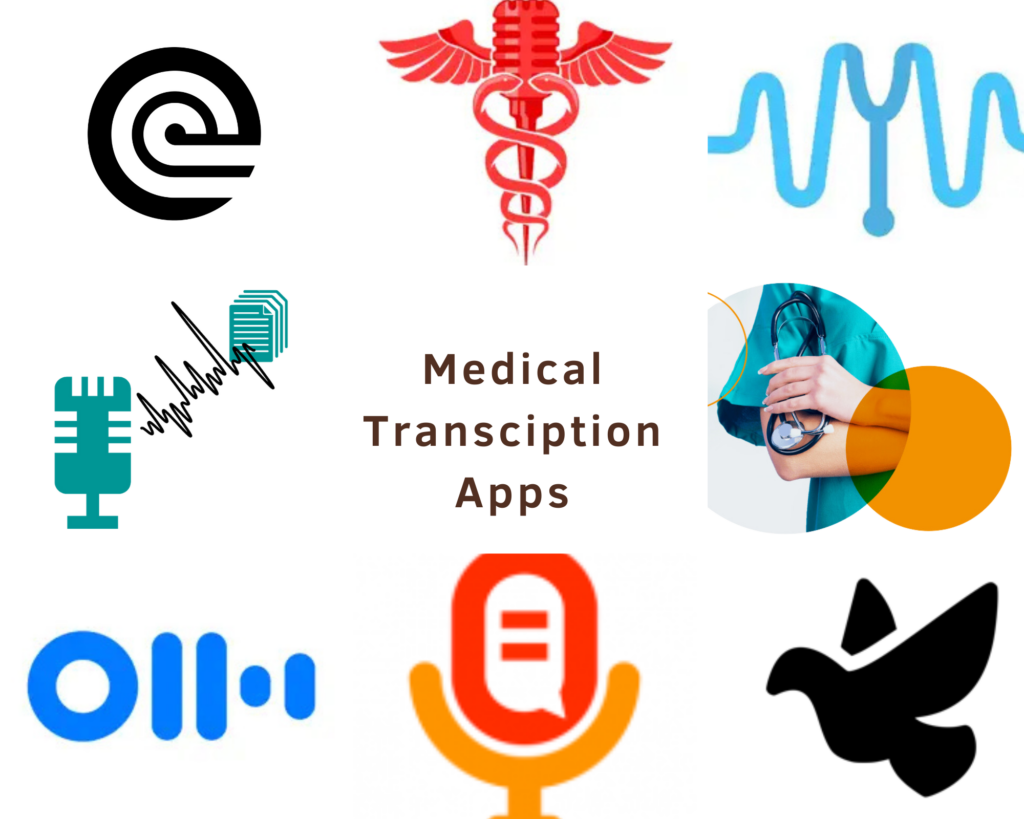
Medical transcription, the process of turning spoken medical dictation into written reports, has become faster and more efficient with the help of specialized apps. These tools offer features like AI-powered accuracy, offline access, and integration with Electronic Health Records (EHR), making documentation easier, reliable, and less time-consuming for healthcare professionals. Whether you’re a doctor, medical transcriptionist, or part of a healthcare team, choosing the right app can save time, reduce paperwork, and improve workflow efficiency. In this blog, we explore some medical transcription apps that are transforming healthcare documentation. Comparison Table of Medical Transcription Apps App Name Platform Key Features Best For Pricing MedXcribe iOS, Web Offline, AI-powered, secure, easy-to-use Medical professionals, offline users Freemium Rev Voice Recorder iOS, Android Manual transcription, high accuracy, fast turnaround Doctors needing human transcription Pay per minute Otter.ai iOS, Android Real-time AI transcription, speaker identification Meetings, notes, discussions Freemium Freed iOS, Android AI-driven, real-time medical note creation Clinicians, small practices Subscription-based DeepScribe iOS AI-powered, automates clinical notes from speech Clinicians, AI-based EHR integration Subscription-based Speechnotes Android Real-time voice-to-text, works offline Freelance transcriptionists, small clinics Freemium Medical transcription apps make documentation faster, easier, and more accurate for healthcare professionals. Choosing the right app based on your needs can save time, reduce paperwork, and allow you to focus more on patient care.
MedXcribe Vs Standard Google Speech-to-Text
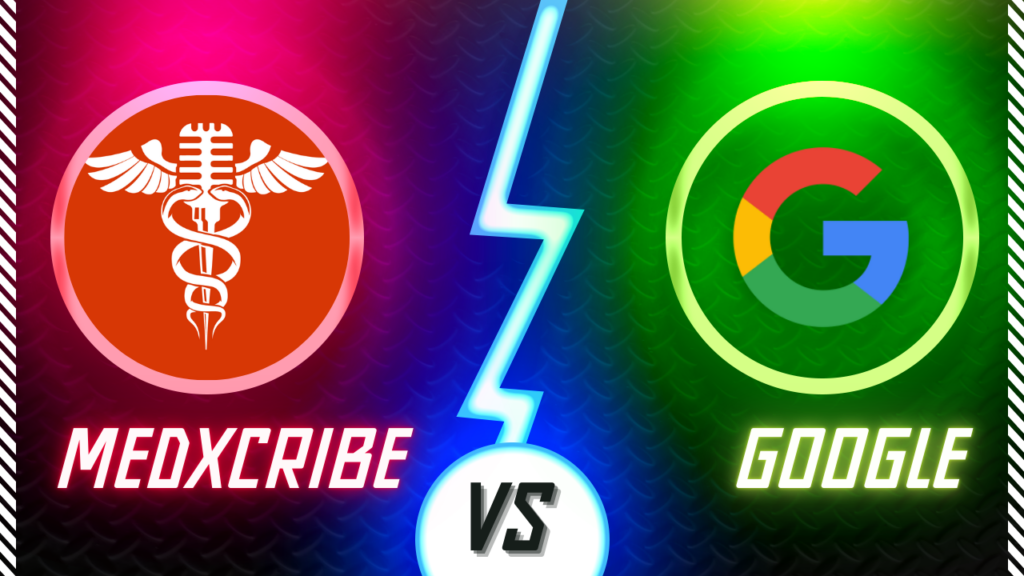
Being a doctor is busy work. You talk to patients, write notes, and manage treatment plans. What if a tool could listen to your conversations and write everything down for you? That’s what speech-to-text tools do. Two well-known options are MedXcribe and Standard Google Speech-to-Text. Based on a comparison of over 70 audio files, MedXcribe consistently outperforms Google Speech-to-Text in accuracy, usability, and features. Let’s look at the details: Comparison Feature MedXcribe Standard Google Speech-to-Text Accuracy Very accurate (97.87%) Pretty accurate (91.22%) Works Without Internet Yes No Understands Medical Words Yes, trained for medical terms No, made for general use Customizable Yes, easy to adjust Limited customization Data Security Very secure (Offline) Secure, but not as strict
How OpenAI’s Whisper Revolutionizes Medical Transcription?
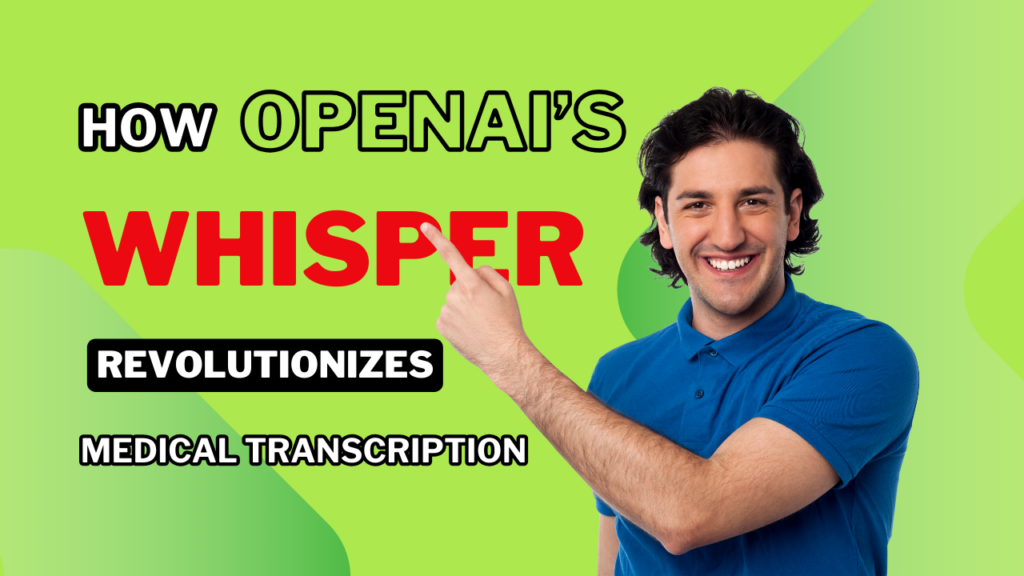
In today’s fast-paced world, accurate and efficient transcription is essential, especially in healthcare, where precise documentation directly impacts patient care. At MedXcribe, we are committed to meeting this critical need. Our journey began with Whisper, OpenAI’s advanced audio-recognition model. Its remarkable accuracy, open-source flexibility, and ability to be customized with specialized medical data inspired us to create MedXcribe—a secure, offline medical transcription app. MedXcribe simplifies workflows, safeguards sensitive information, and delivers consistently accurate results, empowering healthcare professionals with a reliable tool for their documentation needs. Here’s how Whisper technology enhances transcription accuracy and earns the trust of professionals. Whis is Whisper? Whisper is a powerful tool that converts spoken words into written text with high accuracy and can also translate speech from one language to another. It supports multiple languages and accents, making it ideal for tasks like transcribing recordings, providing live transcriptions, and bridging language gaps through translation. Even in noisy environments, Whisper delivers clear, precise results. In healthcare, Whisper ensures accurate medical transcription and translation, improving documentation, patient care, and communication with non-native speakers. It also benefits industries like journalism, customer service, research, and education by simplifying workflows, capturing critical information, and enhancing cross-language communication. How Does Whisper Work? Whisper ensures accurate transcription through a series of well-designed steps: Audio Preprocessing: The audio is divided into small segments and converted into visual images called spectrograms. Feature Extraction: Whisper uses deep learning to identify important details within these spectrograms. Language Identification: If the language of the audio isn’t known, Whisper determines it from the languages it supports. Speech Recognition: The system predicts the most likely words spoken based on the extracted features. Translation (Optional): If needed, Whisper can translate the recognized text into another language. Post-processing: The final text is refined to improve accuracy and readability. Benefits of Using Whisper Whisper provides several important advantages that set it apart: High Accuracy : Whisper delivers excellent transcription results, especially for podcasts, lectures, and interviews. Multilingual Support : It can transcribe over 57 languages and translate from 99 languages to English. Handles Noise and Accents: Whisper performs well even with background noise and different accents, ensuring reliable transcriptions in various settings. Open-Source : Being open-source allows developers to customize and improve Whisper to meet their specific needs. Flexible Options : Whisper offers both free tools and paid APIs for cloud-based processing, catering to different user preferences. Cost-Effective: Its pricing is competitive compared to other transcription services, making it accessible for many users. The Role of Whisper in Transforming MedXcribe’s Transcription Services The diagram provides a detailed look at the workflow by which the MedXcribe app leverages a fine-tuned Whisper model to perform medical transcription. Below is an explanation of each component and their roles within the process: Whisper Model Base: This is the foundational Whisper model from OpenAI, which is used as the starting point for customization to meet the specific needs of MedXcribe. Fine Tuning: In this crucial step, the base Whisper model is customized using medical audio recordings paired with accurate transcripts. This adaptation helps the model better understand and transcribe medical terminology and context. Medical Audios With Transcripts: These inputs for fine-tuning consist of medical environment audio recordings, which come with corresponding text transcripts. They enable the model to learn the unique language, terms, and communication style of the medical field. MedXcribe Fine Tuned Model: Post fine-tuning, this tailored model is equipped to handle medical transcription tasks with enhanced accuracy and efficiency. Stored & Powering MedXcribe: Once fine-tuned, the model is stored in a secure and accessible location and integrated into the MedXcribe infrastructure. It then powers the app, providing essential transcription services. MedXcribe App: The final interface that medical professionals use, which harnesses the fine-tuned Whisper model to convert medical speeches, discussions, or consultations into written text, thereby aiding healthcare providers in maintaining precise and efficient records. This step by step process, from the base model to a user-ready application, highlights the deployment and development of AI capabilities specifically tailored for medical transcription within the MedXcribe app. Statistical Evidence of Whisper’s Enhanced Transcription Accuracy When it comes to accurate transcription, especially in critical fields like healthcare, statistical data plays a crucial role in demonstrating the effectiveness of a tool. Whisper, developed by OpenAI, has shown impressive performance metrics that set it apart from other Automatic Speech Recognition (ASR) tools. Below is a table that highlights how Whisper enhances transcription accuracy: Feature Whisper (OpenAI) Google Speech-to-Text Amazon Transcribe Dragon NaturallySpeaking Advantage Word Error Rate (WER) Common Voice Dataset 5.2% 6.8% 7.1% N/A Whisper is 23% more accurate than Google and 26% better than Amazon Medical Transcription Tasks 4.9% N/A N/A 6.3% Whisper outperforms Dragon NaturallySpeaking by 22% Multilingual Performance Language Coverage Supports over 57 languages Supports over 120 languages Supports multiple languages Primarily English Whisper offers focused language support suitable for specific needs Accuracy in Major Languages >90% Similar accuracy but less consistent across accents Similar accuracy but less consistent across accents N/A Whisper maintains consistency across varied accents Accents and Dialects Accuracy 93% across 10 English accents 88% average accuracy 88% average accuracy N/A Whisper is better at handling different accents Noise Robustness Performance in Noisy Environments 91% accuracy in simulated hospital settings 84% accuracy 82% accuracy N/A Whisper is 7-9% more accurate in noisy environments compared to leading ASR tools Real-Time Transcription Latency and Accuracy Latency under 1 second, WER 5.5% Latency 1-2 seconds, WER 6-7% Latency 1-2 seconds, WER 6-7% N/A Whisper offers faster transcription with better accuracy Customization Impact Domain-Specific Training 15% improvement in accuracy for medical terms General ASR models have lower accuracy in specialized terminology General ASR models have lower accuracy in specialized terminology N/A Whisper’s customization leads to significantly higher accuracy in specialized fields Data Privacy and Security Offline Operation Can be deployed on local servers, ensuring 100% data privacy Requires data transmission over the internet, posing potential privacy risks Requires data transmission over the internet, posing potential privacy risks Operates offline with very high privacy Whisper provides complete data
Why Efficient Medical Transcription Is Essential?
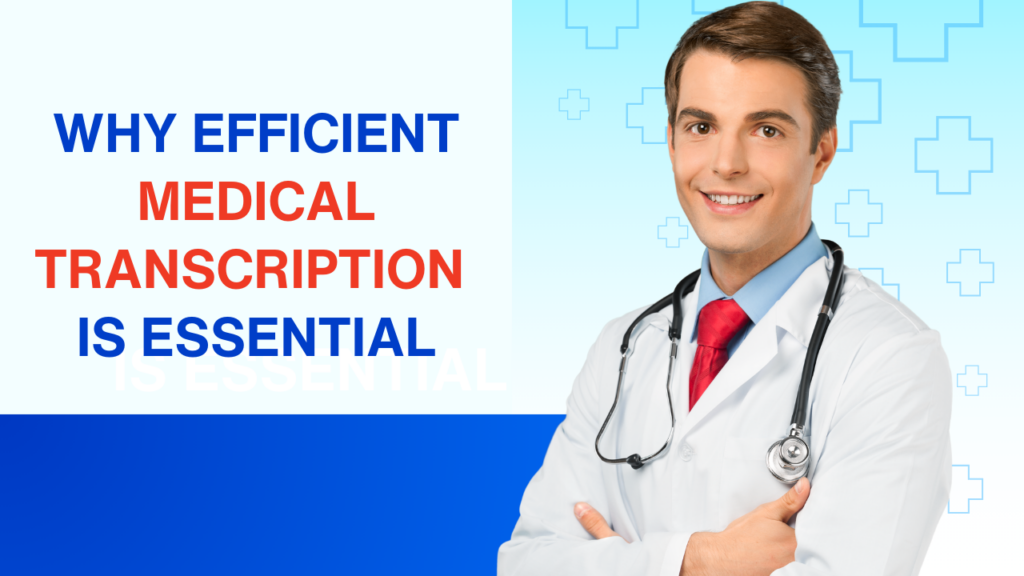
Many doctors today prefer dictation over typing. Yet, I often wonder why so many still type their notes when dictation is much faster. Let me share an example of how much time can be saved by dictating. Consider a patient—a 69-year-old man with heart problems. During his 30-minute visit, the doctor needed to document everything discussed. The note was quite detailed. It took about 3.6 minutes to dictate the note, but if the doctor had typed the same note, it would have taken 13.3 minutes at their typing speed.(ref:”Dictating your notes during the Patient visit“) But speed isn’t the only thing that matters. Doctors aim to provide excellent care, build strong relationships with their patients, and keep their practices running smoothly. Dictating notes while the patient is present is beneficial for both the doctor and the patient. It saves time and strengthens the treatment plan by ensuring the patient understands and can provide immediate feedback. To make dictation work well, doctors need the right tools. That’s where the MedXcribe App comes in. The MedXcribe App is built specifically for medical transcription, allowing doctors to dictate notes anytime, even without an internet connection. Your smartphone becomes a secure place to store your notes. You can dictate while on the go, and when you’re back online, easily transfer them into your electronic medical records. Switching from typing to dictating notes saves time and reduces stress. With the MedXcribe App, it’s easy to make this change. It helps doctors spend more quality time with their patients—which is why they became doctors in the first place. Let’s review how MedXcribe App revolutionizes offline medical transcription and help you decide if real-time dictation is the right documentation workflow for your practice. Benefits of Dictating Clinical Notes with MedXcribe App in the Presence of Your Patients Many doctors have realized the benefits of medical dictation as a substitute for typing clinical notes. However, fewer have embraced the advantages of completing dictation during visits. MedXcribe App makes this process seamless—even without internet connectivity. Here are five compelling reasons to adopt a documentation workflow that includes dictating in the presence of your patients using MedXcribe App. 1. Faster Documentation We speak faster than we type, so dictating clinical notes during the exam saves time. Most doctors type about 30 words per minute, but we speak around 150 words per minute. Even with pauses and choosing our words carefully, dictating is still the quickest option.(ref:”Dictating your notes during the Patient visit“) With the MedXcribe App, you can save even more time by dictating during the patient visit. Instead of repeating care instructions to make sure the patient understands, start dictating while highlighting important details. This way, talking with the patient also becomes your documentation time. 2. Better Quality Care Most family doctors see about 15 patients each day. If you wait to write your notes until later or stay up late to finish them, it can be hard to remember everything. Think about this: if you don’t dictate your notes, the system might save about $7.72 per patient, but it costs you 9 minutes of your time for each one. For 15 patients a day, that’s 2 hours and 15 minutes of extra work for you, while the system saves about $116. (ref:”Dictating your notes during the Patient visit“) By dictating your clinical notes during each visit with the MedXcribe App, you capture important information while it’s still fresh in your mind. Speaking this information also lets you review it with the patient, who can correct any mistakes or add important details. Working together with your patient in this way can improve their cooperation and ultimately make the quality of care better. 3. Improved Patient Satisfaction Dictating notes in front of your patients can make their experience better. Patients want to feel heard and understood. By repeating your diagnosis and treatment plan while they’re there, you show that you fully understand their condition. With MedXcribe App’s easy-to-use interface, you can say, “I’m going to dictate some notes into your medical record to make sure we get everything right.” Since patients already have access to their medical notes due to federal rules, they can read them anyway. By dictating during the visit with MedXcribe App, you clear up any confusion or misunderstandings right away. 4. Lower Risk of Malpractice Dictating clinical notes while the patient is present can reduce the chance of malpractice claims. When doctors review notes with patients, the records become current, witnessed, and approved by the patient. Inviting patients to correct or add information makes charts more complete and accurate. The MedXcribe App allows doctors to easily include phrases like “dictated in the presence of the patient.” This can offer strong protection if any disputes arise. Research shows that better communication with patients lowers malpractice risks. Behaviors linked to fewer malpractice claims include: Explaining the visit: Letting patients know what to expect. Using humor: Building a good relationship and easing their anxiety. Encouraging conversation: Asking for patients’ opinions and checking their understanding. Dictating during a visit with MedXcribe App provides many opportunities for doctors to communicate effectively with their patients. 5. Increased Income When medical records fully reflect the entire patient visit, doctors can bill for higher-level services. This means better payment compared to notes that only capture some details. By documenting in real-time with the patient’s input using the MedXcribe App, doctors are more likely to create complete and accurate notes, leading to improved earnings. Also, think about the value of a doctor’s time. Studies show that using medical dictation speeds up documentation by over 30%, and the time saved can greatly boost income. Even a small effort to learn a new dictation method with MedXcribe App can pay off over time. For example: Cost of Traditional Transcription Services: If transcription services cost $40 per hour and a doctor uses about one day’s worth per week, that’s approximately $8,800 per year. Lost Income from Typing Notes: If typing notes means seeing two fewer patients per
Introducing MedXcribe: The Offline Medical Transcription App for Professionals and Students
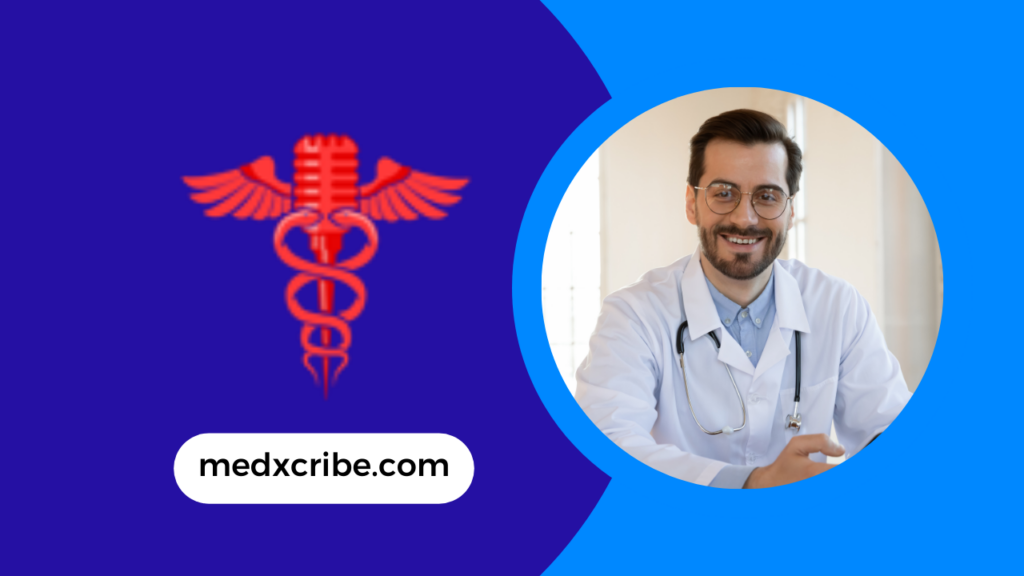
What is MedXcribe? MedXcribe is a medical transcription app designed specifically for medical professionals and students. It enables users to take efficient notes—whether it’s patient-related information or lecture notes from professors. Inspired by the standalone generic transcription app ScribeAI, MedXcribe brings specialized features tailored for the medical field. Why Choose MedXcribe? While there are several medical transcription apps available on the App Store and Play Store, MedXcribe stands out for two main reasons: Advanced Technology: MedXcribe utilizes the latest speech-to-text technology to provide highly accurate transcriptions, even for complex medical terminology. Offline Functionality: Unlike many other apps, MedXcribe operates completely offline. This ensures data privacy and allows you to transcribe notes without an internet connection. The Technology Behind MedXcribe MedXcribe is built using Whisper, a leading speech-to-text AI model developed by OpenAI. Whisper is an open-source model that converts voice to text. MedXcribe has fine-tuned this generic model with real audio recordings from medical professionals to enhance its accuracy in medical contexts. Key Features: Specialized Medical Vocabulary: Continuously trained with complex medical terms and medication names, MedXcribe ensures accurate transcription of specialized vocabulary. Enhanced Accuracy: Fine-tuning with real medical audio data improves transcription precision compared to generic models. Complete Offline Capability: All processing is done locally on your device, safeguarding sensitive information and providing access without the need for internet connectivity. Experience seamless and secure medical transcription with MedXcribe—your reliable companion for accurate note-taking in the medical field.
